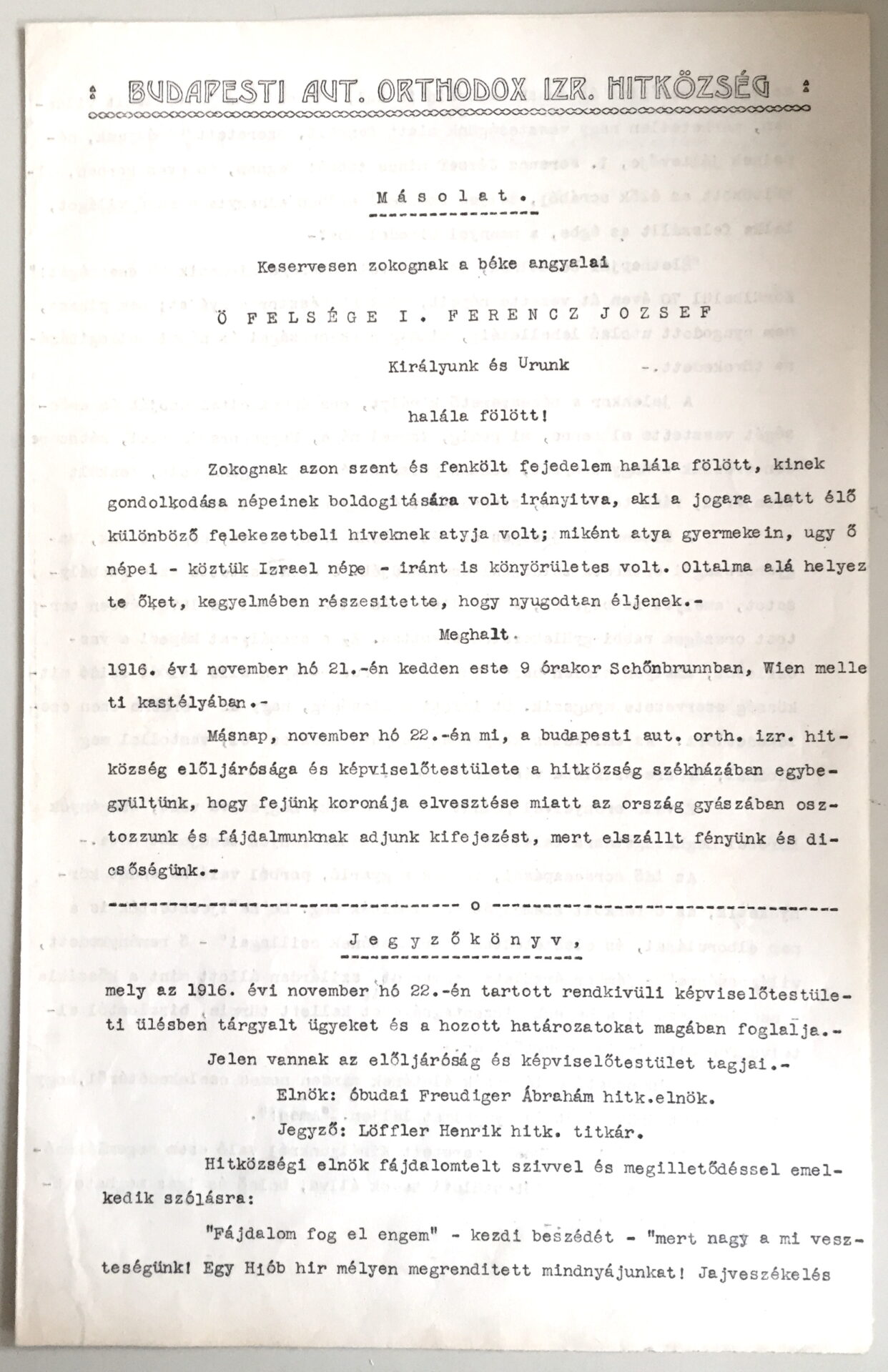Ferenc József és IV. Károly alakjának orthodox zsidó értelmezései
A Ferenc Józsefhez való viszonyulást a vallási hagyományokon túl a zsidóság kései konfesszionalizálódásában játszott uralkodói szerepe és a belső irányzati viták során tett szimbolikus gesztusai szintén meghatározták. Ferenc József a zsidó közbeszédben Mária Terézia ellentéteként jelent meg. Ferenc József 1869-es szentföldi látogatása során Jeruzsálembe bevonulva megcsókolta az elé vitt Tórát.
1857-ben Óbudán Goldberger Erzsébethez és gyerekeihez intézett szavai, miszerint népei irányában a valláskülönbség nem képez válaszfalat a szívében, az uralkodó jóindulatáról tanúskodó toposzként, kiemelt helyen jelentek meg az Orthodox Irodához közeli sajtóban. 1894-ben a király hasonló megnyilatkozásaként a balassagyarmati orthodox hódoló küldöttséghez intézett szavait a hitközség márvány emléktáblára vésette. A király oltalmazó gesztusként értelmezett kijelentésének hitközségi emlékké alakítása általánosabb gyakorlat volt. A Zsidó Hiradó ezt követendő példaként mutatta fel a magyarországi orthodoxia számára.
A dualizmus idején az orthodox sajtó visszatérően közölt történeteket, folklorisztikus feldolgozásokat, csodás elemekkel teli szövegeket, amelyek Ferenc József zsidóság irányában tett uralkodói gesztusairól és nagyságáról szóltak. Az uralkodóházhoz és a koronás főhöz kötődő események között – naptári rítus jellege okán is – kiemelkedett a király születésnapjának izraelita megünneplése. Az orthodox sajtóban és a MAOIH levéltári anyagában erre egyaránt találunk számos példát 1918-ig.
Az Orthodox Iroda véleményét képviselő lapok a talmudiskolák és az orthodox rabbik esetében egyaránt az uralkodó iránti lojalitás terén is különállásukat és uralkodói elismertségüket törekedtek kihangsúlyozni. A császárnál, később császár-királynál kieszközölt audienciák emlékezete is ezt az önképet erősítette.
Ferenc József így főként az orthodox izraelita értelmezésekben a zsidóságot védelmező, mélyen vallásos katolikus uralkodóvá vált. IV. Károlyt az örökölt uralkodói szerep erre predesztinálta. Az új uralkodó koronázásán részt vett Jákov Koppel Reich orthodox főrabbi is, a Budapesti Autonóm Izraelita hitközség pedig a Kazinczy utcai főtemplomban koronázási istentiszteletet tartott.
A dualizmus, mind a neológ, mind pedig az orthodox sajtó két világháború közötti emlékezeti kánonjában pozitív időszakként jelent meg. Az uralkodó – Ferenc József és IV. Károly – személyét hasonló megítélés övezte. A két császár-király kora a két világháború közötti időszakban szimbólummá vált. Az orthodox szervezet fővárosi lapja jól tükrözi ezt: Ferenc József kora 1930-ra letűnt aranykorrá lett. „Ferenc Józsefre emlékezve, egy nagy múlt légköre száll felénk s eltölti szívünket a nosztalgia, a fájó vágy a régi, jobb idők után, amikor több volt a kenyér, szilárdabb a béke és erősebb a szellemiek utáni vágy.” – írta a szerkesztő.
(Zsidó Újság 1930. aug. 22./ 3. Emlékezés I. Ferenc Józsefre)
Orthodox Jewish interpretations of the figures of Franz Joseph and Charles IV
Beyond religious traditions, the relationship toward Franz Joseph I. was shaped by his role as ruler in the late confessionalisation of Judaism and his symbolic gestures in the internal debates over policy. In Jewish public discourse, Franz Joseph I was the antithesis of Maria Theresa. On his visit to the Holy Land in 1869, Franz Joseph I kissed the Torah that was brought before him as he entered Jerusalem.
His words to Elisabeth Goldberger and her children in Óbuda in 1857, to the effect that religious difference was not a barrier in his heart towards his peoples, were prominent in the press close to the Orthodox Office as a topos of the benevolence of the Emperor. In 1894, similar words of the King addressed to the Orthodox missionary delegation from Balassagyarmat were engraved on a marble memorial plaque by the community. It was a most common practice to turn the King’s statement into a religious community memorial. The Zsidó Híradó presented it as an example for Orthodoxy to follow.
During the period of the Dual Monarchy, the Orthodox press repeatedly published stories, folkloristic adaptations, texts full of mystical elements, which spoke of the royal gestures and greatness of Franz Joseph I towards the Jews. Among the events connected with the royal house and the crowned head, the Israelite celebration of the king’s birthday stood out, also because of its special calendar rite. There are numerous examples of this in the Orthodox press and in the archives of the MAOIH up to 1918.
The newspapers representing the views of the Orthodox Bureau also sought to emphasise their distinct status and recognition by the ruler, both in the case of the Talmud schools and the Orthodox rabbis. The memory of the audiences with the emperor, and later the emperor-king, reinforced this self-image.
Franz Joseph I thus became a deeply religious Catholic ruler, defending Judaism, especially in orthodox Israelite interpretations. Charles IV was predestined for this by his inherited ruling role. The coronation of the new monarch was attended by the Orthodox Chief Rabbi Jacob Koppel Reich, and the Autonomous Jewish Community of Budapest held a coronation service in the main church on Kazinczy Street.
The Dual Monarchy era was represented a positive period, in the common canon of the Neolog and Orthodox press between the two world wars. The reigning monarchs, Franz Joseph I and Charles IV, were regarded similarly. The age of the two emperor-kings became a symbol in the inter-war period. The capital’s newspaper of the Orthodox organisation reflects this: The era of Franz Joseph had become a golden age by 1930. “Remembering Franz Joseph, we are filled with the atmosphere of a great past, nostalgia and aching longing for the good old days, when there was more bread, peace was more solid and the desire for spirituality was stronger." – wrote the editor.
(Zsidó Újság 22 Aug 1930 / 3. Commemoration of Franz Joseph I)

Jegyzőkönyvi kivonat a Budapesti Autonóm Orthodox Izraelita Hitközség 1916. nov. 22-én tartott rendkívüli képviselőtestületi üléséről.
Excerpt from the Extraordinary Meeting of the Council of the Autonomous Orthodox Jewish Community of Budapest, 22 Nov. 1916.
© MAOIH Levéltára